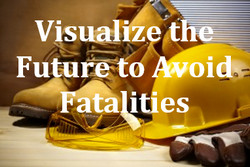A few days ago, I had the opportunity to hear Mark Breslin, a professional speaker, author and strategist (Breslin Strategies), talk about his approach to going beyond compliance in safety performance.
He made the point that the two most important things to people in the workplace are:
- to be sincerely praised and recognized; authenticity is key
- to be given the opportunity to make decisions; autonomy
People need to know that management cares. These important ideas are quite consistent with some of our ideas in Partner-Centered Safety.
 In our Partner-Centered Safety realm, we go beyond this to having everyone (the people on the floor, the supervisors, the managers, and all the others) feel they are cared about. Caring means helping each other, listening to each other, sharing information, being respectful, asking for help and receiving it, looking out for each other, saying we are sorry when we make a mistake, and treating each other as whole persons. Just what caring means for people is something on which they should all agree. Management, alone, should not do it for their approach can often be quite patronizing – treating the people in the work place as if they are children. All the people, at all levels, together, need to come up with their ideas about what caring is for them. Management should not try to dictate the answers, but management needs to open up and lead this discussion about caring or it will not be addressed. Caring is visible; as is non-caring. Partner-Centered Safety is visible caring. Mistreatment of people is non-caring.
In our Partner-Centered Safety realm, we go beyond this to having everyone (the people on the floor, the supervisors, the managers, and all the others) feel they are cared about. Caring means helping each other, listening to each other, sharing information, being respectful, asking for help and receiving it, looking out for each other, saying we are sorry when we make a mistake, and treating each other as whole persons. Just what caring means for people is something on which they should all agree. Management, alone, should not do it for their approach can often be quite patronizing – treating the people in the work place as if they are children. All the people, at all levels, together, need to come up with their ideas about what caring is for them. Management should not try to dictate the answers, but management needs to open up and lead this discussion about caring or it will not be addressed. Caring is visible; as is non-caring. Partner-Centered Safety is visible caring. Mistreatment of people is non-caring.
For example, in one plant making large pumps to fracture gas wells, there was a serious injury when a guy tried to hoist a 3,200-pound pump with a 2,000-pound rated overhead crane. The pump fell onto the employee’s hand causing serious damage. When I was talking about this with another man on an adjacent work table about 10 feet away, I asked him if he had seen what was happening. He said he had. When I asked why he did not stop the work, he said that he was not the other guy’s boss. They had never talked about caring and what it meant to them. This is certainly not caring! Being your brother’s/sister’s keeper was a foreign concept.
In another example, when we have bullies in the workplace, they cause huge destruction in shutting down communications. How can there be an authentic and caring atmosphere with bullies contaminating the environment by picking on people when they speak up and try to contribute. Sometimes, the bully is in supervision, which makes matters worse. Management must deal with them for they are extremely destructive. The culture is set by the worst behavior that is tolerated!
However, when the people all come together to talk about the various ways they want to show caring, treat each other, and agree on ways to work together, the culture quickly shifts towards one that is open, healthy, and where the communications can flow freely. This is the environment where there can be good learning, growth and progress towards safety excellence. This is the environment where people can talk together about their ideas, share opportunities to improve the work, and have the opportunity for making decisions about some of the things going on and how they are cared about and treated.
 In my reading, studying and talking with many people, I have found that over half of the fatal accidents are often unanticipated and missed using our traditional approaches to accident prevention. The Heinrich Accident Triangle is very useful as we look at unsafe acts at the base of the triangle. Lots of slips, trips and falls are avoided as we do this.
In my reading, studying and talking with many people, I have found that over half of the fatal accidents are often unanticipated and missed using our traditional approaches to accident prevention. The Heinrich Accident Triangle is very useful as we look at unsafe acts at the base of the triangle. Lots of slips, trips and falls are avoided as we do this. Overlap: All three of these areas of safety are often lumped together as SHE, EHS or HSE. When we lump these all together we can miss things so I think it is useful to see these three overlapping, interacting areas of our safety and health work. There is some overlap between Occupational Safety and Occupational Health like the proper selection and use of respirators. There is some area of overlap between Occupational Health and Process Safety like preventing chronic exposures to toxic chemicals. There is some overlap between Process Safety and Occupational Safety like locating trailers and offices away from operating areas using large quantities of flammable and explosive materials.
Overlap: All three of these areas of safety are often lumped together as SHE, EHS or HSE. When we lump these all together we can miss things so I think it is useful to see these three overlapping, interacting areas of our safety and health work. There is some overlap between Occupational Safety and Occupational Health like the proper selection and use of respirators. There is some area of overlap between Occupational Health and Process Safety like preventing chronic exposures to toxic chemicals. There is some overlap between Process Safety and Occupational Safety like locating trailers and offices away from operating areas using large quantities of flammable and explosive materials.




